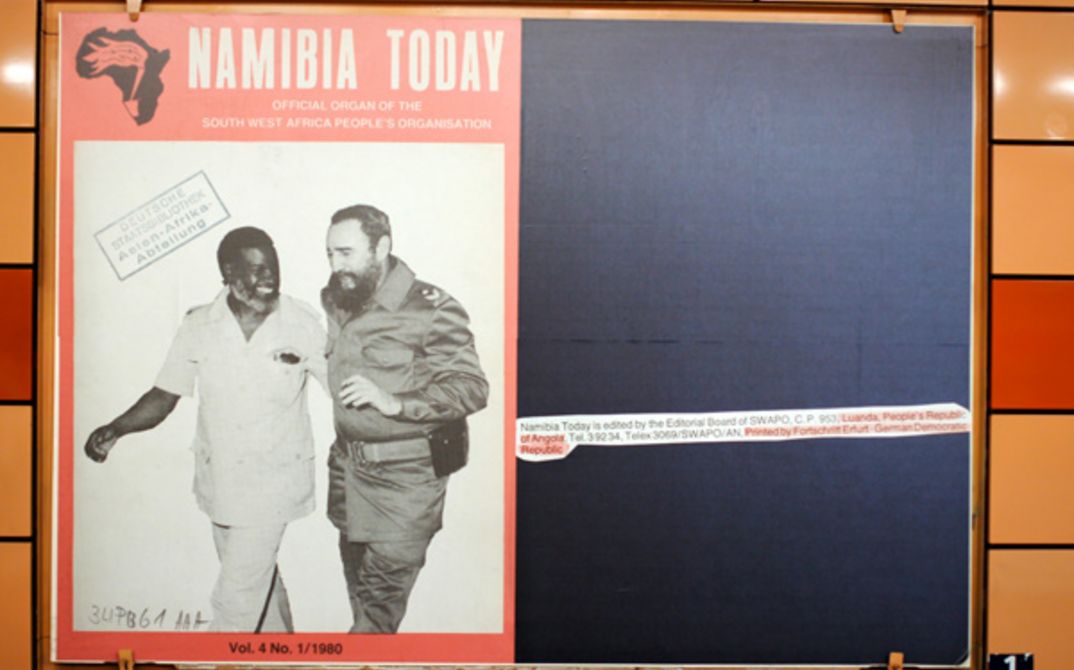Decolonize this Place
Michele Faguet on Laura Horelli’s billboard installation “Namibia Today”
Last July, Germany’s Foreign Ministry delivered a long-awaited acknowledgment that the near extermination of the Herero and Nama peoples of present-day Namibia under German colonial rule in the early twentieth century constituted genocide. Bilateral negotiations about how Germany should atone for this crime are ongoing, but descendants of the survivors have filed a classaction lawsuit in New York seeking direct reparations. Meanwhile, a recent exhibition on German colonialism at the Deutsches Historisches Museum in Berlin has lent credence to the thesis that, while previously dismissed as insignificant, given that it lasted little more than thirty years, Germany’s reign in South West Africa—with its concentration camps, forced labor, and medical experiments—provided a gruesome blueprint for the Holocaust some three decades before the Nazis came to power. Berlin’s art world has been engaging with this episode of German history as well: Earlier this year, at an event hosted by the Sophiensäle theater in collaboration with KW Institute for Contemporary Art, Cuban-American artist and writer Coco Fusco read native testimony from the so-called “Blue Book” (1918), which collates graphic eyewitness accounts of the massacre.
Against this background, the Finnish-born, Berlin-based artist Laura Horelli has revisited a later and more obscure chapter of German-Namibian relations: During the 1980s, motivated by the desire to distance itself from both colonial Germany’s morally unpalatable legacy and West Germany’s purportedly neocolonialist policies in Africa, the East German government financed and printed the English-language periodical of the South West Africa People’s Organisation (SWAPO)—the Namibian liberation movement that successfully brought about the country’s independence from South Africa in 1990, the same year that the GDR ceased to exist. Horelli has used this story to create a public artwork, “Namibia Today”, 2017, titled after the periodical and commissioned by the Neue Gesellschaft für Bildende Kunst in Berlin, as part of its Art in the Underground program.
A sequence of billboards lining the walls of the Schillingstraße subway station features covers spanning the periodical’s production in the GDR from 1980 to 1985 alongside related collaged text and images. One shows SWAPO leader and future Namibian president Sam Nujoma with Fidel Castro at the Sixth Summit of the Non-Aligned Movement in Havana, which is juxtaposed with a clipping of the printing credit of Druckerei Fortschritt in the East German town of Erfurt. Another, depicting swapo trainee soldiers perched on a downed South African military helicopter, is coupled with a photograph of printing-house representatives reviewing proofs.
Other carefully considered compositions visualize a set of micro-histories that captured the artist’s attention, like the story of the so-called Ossis (i.e., East Germans) of Namibia—hundreds of child refugees educated and trained in the GDR to become the future elite of an independent country, only to be abruptly sent back following the fall of the Berlin Wall to a culture they were ill equipped to understand. Another focuses on the Finnish Peace Committee’s donation of the high-grade paper that distinguished “Namibia Today” from other periodicals printed at the time in East Germany. In one of the collaged images, Horelli has colorized the dresses and aprons in a black-and-white photograph of an all-female bookbinding collective, the playful gesture accentuating the tacky late-1970s aesthetic often associated with GDR culture while drawing attention to how the archived documents Horelli found are populated nearly exclusively by men.
Displayed below the iconic Karl-Marx-Allee, with its Stalinist architecture that once housed elite party members (and where the artist herself currently resides), the eighteen billboards provide visual evidence of the proletarian internationalism that spurred a small, ethnically homogenous country behind the Iron Curtain to support revolutionary movements in Africa and across the developing world. The installation moves away from the pathos of memoir characteristic of much of Horelli’s work—for which she has drawn from autobiographical details such as her childhood among Finnish relief workers in Nairobi—to the comfort of the archive to comment, if obliquely, on the present-day moral and ideological ramifications of neglected or repressed histories. Like Germany’s confrontation with its colonial war crimes, the artist’s emphatically public remembrance of a brighter moment in German history takes place amid the rise of right-wing populism, which is most prevalent in those parts of the country that have historically felt the most defeated, namely the former East. It is not insignificant, then, that “Namibia Today” is installed on a subway line that currently only runs east from Alexanderplatz, toward neighborhoods where socialist solidarity with the developing world has largely ceded to anti-refugee rhetoric driven by fear and economic self-preservation. Horelli’s detournement of the space of advertising to draw attention to the intersecting histories of Namibia and East Germany suggests that not only another past is possible—but another future, too.
“Namibia Today” was on view at the Schillingstraße subway station in Berlin February – October 2017.
Michele Faguet is a writer and editor living in Berlin.
© Artforum, September 2017, “Decolonize This Place: Michele Faguet on Laura Horelli’s ‘Namibia Today,’” by Michele Faguet.
